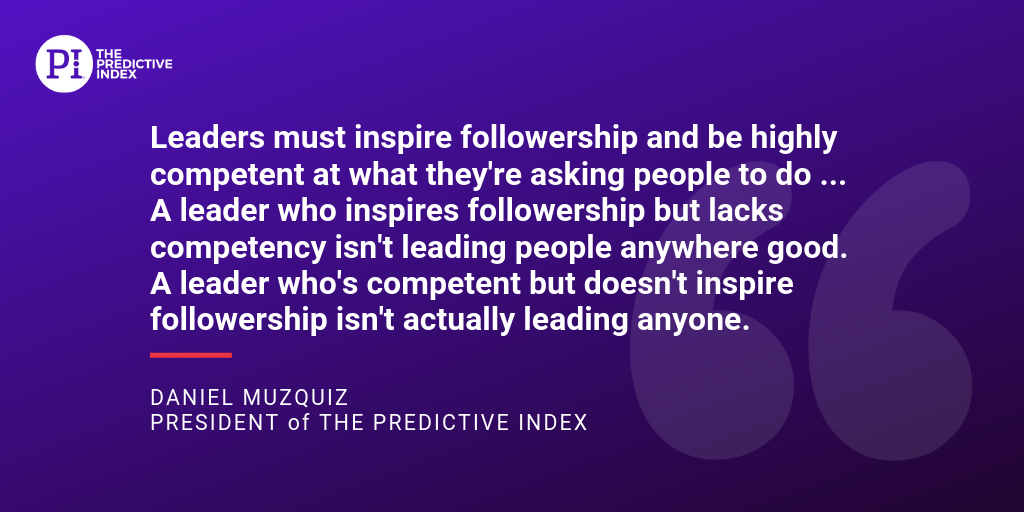What is leadership capacity?
Leadership capacity is your ability to change the way in which you lead to develop more effective ways to get results. To be a good leader, you need to have a solid understanding of both the work that you are doing and people as a whole. To be a great leader, you need to add adaptability to this. That’s where building leadership capacity comes in.
Why is it important to build leadership capacity?
Because the war for talent is raging, and your ability to develop your employees can help you attract and retain top talent. (According to the 2020 State of Talent Optimization Report, 47% of high-performing employees left their company last year.)
Employee retention depends heavily on employee engagement. While engagement as a whole is a large subject, there’s little debate that mastery helps drive engagement. Feeling like you’re getting better at something—it feels good, right? It makes you want to continue pushing forward, even when it’s difficult.
Contrary to popular belief, leadership is a skill. It’s something you can learn. And, in the process of learning and developing your leadership style, you start to feel fulfillment: ‘I’m better today than I was yesterday.’

This building of leadership skills should be a more valuable, outsized focus—for both businesses and employees—because business rewards effective leadership more than other skills. While they’re harder to develop and more intangible to define, building them up has disproportionate rewards for employees. Businesses need leadership in spades in today’s environment.
Since the modern economy demands effective leaders at all levels for companies to remain competitive, it’s no surprise that increasing employees’ mastery of leadership will create a more engaged workforce.
The core competencies of leadership
When I think about leadership, I think about the integration of four core competencies or key skills that a great leader should possess. While leadership competencies will vary depending on the organization, these are generic building blocks leaders should be working with.
1. Leaders are self-aware.
Our People Management Study showed that a common characteristic among good managers is self-awareness. When I think about self-awareness, it comes down to locus of control. Is somebody not just self-aware but do they take ownership of their awareness?
2. Leaders show a true appreciation for others.
Good leaders genuinely care about the people around them. This is different than creating followership. This care is more about genuine interactions and caring about the relationships, not just what the relationships will ultimately enable them to do.
3. Leaders inspire followership.
Followership asks the question: Is this person capable of getting people to put resources and energy toward whatever goal that leader has appointed?
4. Leaders are highly competent.
Complementary to the skill of inspiring followership is competency in what they’re asking people to do. Have they mastered something, are they capable of mastering something, or are they in the process of mastering something that would allow them to effectively lead others as well as train the next generation of leaders via mentoring?
Those last two attributes really depend on each other, because a leader who inspires followership but lacks competency isn’t leading people anywhere good. A leader who’s competent but doesn’t inspire followership isn’t actually leading anyone.

How to build leadership capacity
1. Start by knowing yourself.
Every leader has weaknesses. Maybe you’re great at developing ambitious ideas, but not great at filling in the details. Maybe you’re a ruthless negotiator with other firms, but you struggle to make important compromises with your coworkers.
That’s not a point of shame—it’s just a fact of life. But to build leadership capacity, you need to know what your weaknesses are. After all, without knowing your weaknesses, you’ll have no way to adapt.
Just taking the time to reflect and write down potential weak spots can go a long way. But it could also help to have honest conversations with people you trust. Ask them: When am I best at leading? When do I struggle?
Once you’ve compiled a list of weak spots, choose 2-3 you want to focus on. Then, move on to the next step.
2. Analyze a situation.
If you have a vague plan to improve a weak spot, you might succeed—or you might not. Like with most endeavors, self-improvement is easiest when you have a concrete plan. Ironically, the best way to achieve that is a sense of imagination.
First, imagine a specific situation where your weak spot could become an issue. For example, if you have trouble delegating, think of a situation where that would become an issue. Maybe you have two different mission-critical projects—and you don’t have the capacity for both.
Then, imagine how you would typically respond now. In particular, think about how you usually get from Point A to Point B.
Do you tend to think, feel, or act certain ways when you’re confronted with the weak spot? For example, if you have problems delegating, maybe you feel pressure to perform. Maybe you respond to that pressure by working through the weekend.
What negative results are caused by those thoughts, feelings, or actions? e.g., maybe the week afterwards, you’re usually left stressed, tired, and disengaged.
3. Develop your own development plan.
Finally, imagine specific interventions that could help instead. To continue the delegation example, maybe you could try to be more self-aware about when you’re putting unnecessary pressure on yourself. Or maybe you could overestimate how much time projects will take, so you’re not tempted to put too much on your plate.
This is also a great time to look into structured skill development. You might consider classes or other leadership-building activities.
4. Create accountability.
We’ve all heard the cliche: Someone makes a grand resolution at New Years, and the next week they’re back to normal.
Change is hard. That’s why committing to action isn’t enough. Instead, you need to create accountability for change.
Schedule a thirty minute meeting with yourself a month or two out. Then, when the meeting arrives, take time to reflect. Did you make the changes you wanted to? If you didn’t, what obstacles got in the way? How can you overcome those obstacles in the future? Then, if needed, schedule another meeting.
5. Be kind to yourself.
Developing leadership capacity isn’t something that happens in a day, a week, or even a year. It’s a constant process that evolves across your entire career.
If you can’t change your leadership style overnight, that’s okay. As long as you’re practicing self-awareness and putting in the work, you’ll get where you need to be.
Building leadership capacity at different levels
Leadership competencies don’t necessarily change at each level, although the expectation differs.
For example, an independent contributor might start developing self-awareness around what’s in their locus of control—themselves. This might be as simple as saying “um” less or identifying when they become paralyzed by overanalyzing a situation. As these independent contributors grow, and new skills are developed, that awareness will expand to include the impact those actions have. (Ex: “When I get in the grip, this is how it prevents me from making better decisions, which, in turn, prevents others from wanting to follow me.”)
Mastery needs to go up substantially as you grow in business. If you have a gaping hole in one of these areas, you won’t be successful as you grow and climb the ladder.
The good news is that practicing these self-correcting mechanisms becomes easier as you grow in leadership capacity. The process itself becomes more efficient as you go. In the beginning, it can be all-consuming to practice this kind of self-awareness and reflection, but as you grow in seniority, you’ll be able to reflect more quickly.
The leadership myth most of us buy into
Many of us have assumptions about the kind of personality that works—or doesn’t work—when it comes to good leadership. The reality is that while some behavioral patterns may be naturally more inclined toward leadership positions, you can make any behavioral profile work. It really depends on the environment and the level of leadership training the person has received.
First, you’ll want to take a look at your specific organization’s business needs and the kind of leadership team you’re looking to develop. Do you need effective leaders who are more aggressive and direct in their decision-making? Or would a leader with a more collaborative approach be a better fit, where all team members get a say? Do you need leaders who are innovative or wired to comply with rules? Understanding what your business needs from its leadership is half the battle in building leadership capacity within your organization.
The Predictive Index is a fast-growing tech company. We have ambitious goals for the year that require people who are agile, innovative, and creative. For this reason, many of our most successful leaders have behavioral patterns that are geared toward innovation and agility. My Reference Profile is a Venturer. While my behavioral pattern works great for my role as president here at PI, a fast-growing tech company, I may not be a great fit in another environment that requires no errors and really thoughtful execution.

Common mistakes in building leadership capacity
It’s okay to make mistakes. We all do it. But there are two mistakes I see potential leaders make time and again that just don’t serve them in their leadership capacity development.
1. They use behavioral preferences as an excuse to not adapt to leadership demands.
We’re all wired differently. The key is to not use our natural inclinations as excuses for not embodying true leadership behaviors. For example, leaders who are less extraverted may use that as a rationale for never speaking up in a meeting—a critical skill for leaders to develop.
2. They aren’t direct with feedback.
To a large extent, leadership is learnable. Unfortunately, teaching leadership is hard. The biggest mistake by far is not being direct with giving feedback. Some employees really want to be a leader, but can’t get a clear answer about what everyone else knows they need to work on because there isn’t the courage to be honest with the person. Our People Management Study found that the average employee would rather receive more feedback than less—so give your people the feedback they need to grow.
Measuring leadership capacity
When it comes to measuring leadership capacity, there’s no clear cut way to approach it. It’s often easier to say “This person doesn’t have it” than “This person has it” in the interview process.
Here’s what I’m looking for when trying to determine the leadership capacity of a staff member:
Ability to reflect on better ways to problem solve
A good business leader looks at what they’ve done before and what they could do better. They’re big advocates for professional development. If someone’s illustrating a narrative, they’re explaining what happened—not why something worked or didn’t work. When looking for future leaders, I look at, “Can this person use heuristics? That is, can they deduce how a problem should be solved, even if they don’t know the exact solution? Or are they good at solving discrete problems, and that’s it?”
Cognitive ability
As a general rule, being able to manage more people comes with more complex metrics, systems, and controls. In order to think further out, you also need to be able to manage more complex systems. These attributes are highly correlated with cognitive ability. Cognitive scores are our best bet at measuring the likelihood that someone will be able to handle the increasing complexities of growing in a leadership capacity.
How they perceive problems
There’s a saying, “When you’re a hammer, everything looks like a nail.” If someone tends to apply the same approach to every problem, that may be a sign they’re not ready to progress as a leader. While history does repeat itself, not every business problem is the same, so being able to look critically at a problem is a key leadership skill.Implementing leadership development programs helps build leadership capacity within the organization—improving both the employee experience and providing better career pathing.
Leadership Capacity FAQs
How do you demonstrate leadership capacity?
Since leadership capacity is your ability to change your leadership style to suit the current need, you can demonstrate leadership capacity by being adaptable.
In particular, you can focus on leading in ways that are unfamiliar or uncomfortable to you. There’s an important caveat here: Don’t lead in a different way just to do it. But if you notice a gap between how you lead and what the company needs, you have a great opportunity to demonstrate leadership capacity.
How do you increase leadership capacity in others?
You can’t force someone to be more self-aware or adaptable. But if your employee or coworker is open to change, you can support them in their journey.
This usually starts with honesty. Let them know what kinds of leadership they excel at and where they seem to be struggling. Then, offer to provide mentorship, classes, or other support to fill the gap. If they start to successfully learn how to adapt, let them know.
Change is difficult. But with the right support, most people can develop leadership capacity.
How does leadership capacity differ from leadership skills?
Other leadership skills are concrete. For example, if you’re not a good public speaker, you can improve by becoming a better public speaker.
Leadership capacity is fluid. Learning public speaking could be a part of becoming adaptable, but it wouldn’t “solve” the issue of leadership capacity. Instead, the way to improve leadership capacity is to demonstrate self-awareness. The more self-aware you are, the better you become at adapting.
What are some ways to measure leadership capacity?
Leadership capacity isn’t easy to quantify, in the same way it’s not easy to quantify how good someone is at mentorship.
That said, there’s several qualitative measures of leadership capacity. A ‘yes’ to any of the answers below indicates leadership capacity.
- Do they take criticism thoughtfully and seriously?
- When something isn’t working, do they tend to identify it early?
- When something isn’t working, do they change their approach?
- Are they self-aware and open about their shortcomings?
- Has their style of working changed since they started their job?
Read more on common questions and concerns about implementing leadership development programs in our follow-up blog.
Join 10,000 companies solving the most complex people problems with PI.
Hire the right people, inspire their best work, design dream teams, and sustain engagement for the long haul.


